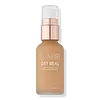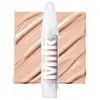Flower Beauty by Drew Get Real Serum Foundation Versus Milk Makeup Sunshine Skin Tint Clean SPF 30 Foundation
What's inside
What's inside
 Key Ingredients
Key Ingredients

 Benefits
Benefits

 Concerns
Concerns

 Ingredients Side-by-side
Ingredients Side-by-side

Water
Skin ConditioningPropanediol
SolventNeopentyl Glycol Dicaprate
EmollientCaprylic/Capric Triglyceride
MaskingTriethylhexanoin
MaskingC9-12 Alkane
SolventGlycerin
HumectantPolymethylsilsesquioxane
Glyceryl Oleate
EmollientC13-15 Alkane
SolventPolyglyceryl-3 Polyricinoleate
EmulsifyingLactobacillus Ferment
Skin ConditioningSilica
AbrasiveSodium Chloride
MaskingSorbitan Isostearate
EmulsifyingLavandula Angustifolia Flower Water
Skin ConditioningQuaternium-90 Bentonite
Magnesium Aluminum Silicate
AbsorbentGlyceryl Caprylate
EmollientCoco-Caprylate/Caprate
EmollientTriethyl Citrate
MaskingLauroyl Lysine
Skin ConditioningOlea Europaea Oil Unsaponifiables
Skin ConditioningAcacia Senegal Gum
MaskingXanthan Gum
EmulsifyingBetaine
HumectantDisodium EDTA
Capric Acid
CleansingPotassium Sorbate
PreservativeTremella Fuciformis Sporocarp Extract
AntioxidantWithania Somnifera Root Extract
Skin ConditioningLavandula Hybrida Oil
EmollientTocopherol
AntioxidantCitric Acid
BufferingSodium Benzoate
MaskingPhenoxyethanol
PreservativeWater, Propanediol, Neopentyl Glycol Dicaprate, Caprylic/Capric Triglyceride, Triethylhexanoin, C9-12 Alkane, Glycerin, Polymethylsilsesquioxane, Glyceryl Oleate, C13-15 Alkane, Polyglyceryl-3 Polyricinoleate, Lactobacillus Ferment, Silica, Sodium Chloride, Sorbitan Isostearate, Lavandula Angustifolia Flower Water, Quaternium-90 Bentonite, Magnesium Aluminum Silicate, Glyceryl Caprylate, Coco-Caprylate/Caprate, Triethyl Citrate, Lauroyl Lysine, Olea Europaea Oil Unsaponifiables, Acacia Senegal Gum, Xanthan Gum, Betaine, Disodium EDTA, Capric Acid, Potassium Sorbate, Tremella Fuciformis Sporocarp Extract, Withania Somnifera Root Extract, Lavandula Hybrida Oil, Tocopherol, Citric Acid, Sodium Benzoate, Phenoxyethanol
Homosalate 5%
Skin ConditioningEthylhexyl Salicylate 4.5%
UV AbsorberOctocrylene 5%
UV AbsorberTitanium Dioxide 2.9%
Cosmetic ColorantZinc Oxide 5.1%
Cosmetic ColorantWater
Skin ConditioningButylene Glycol
HumectantCrambe Abyssinica Seed Oil Phytosterol Esters
EmulsifyingCaprylic/Capric Triglyceride
MaskingSqualane
EmollientGlyceryl Oleate
EmollientPolyglyceryl-3 Polyricinoleate
EmulsifyingPentylene Glycol
Skin ConditioningSilica
AbrasiveDiisostearyl Malate
EmollientSodium Chloride
MaskingStearalkonium Hectorite
Gel FormingSimmondsia Chinensis Seed Oil
EmollientOlea Europaea Fruit Oil
MaskingPersea Gratissima Oil
Skin ConditioningVitis Vinifera Seed Oil
EmollientCitrus Nobilis Peel Oil
MaskingTremella Fuciformis Sporocarp Extract
AntioxidantLonicera Japonica Flower Extract
Skin ConditioningTocopheryl Acetate
AntioxidantTribehenin
EmollientMagnesium Aluminum Silicate
AbsorbentIsostearic Acid
CleansingLecithin
EmollientPolyhydroxystearic Acid
EmulsifyingHydrogenated Olive Oil Unsaponifiables
EmollientAlumina
AbrasiveStearic Acid
CleansingJojoba Esters
EmollientGlycerin
HumectantOlea Europaea Oil Unsaponifiables
Skin ConditioningAcacia Senegal Gum
MaskingEthylhexylglycerin
Skin ConditioningXanthan Gum
EmulsifyingBetaine
HumectantPotassium Sorbate
PreservativePhenoxyethanol
PreservativeParfum
MaskingIron Oxides
Homosalate 5%, Ethylhexyl Salicylate 4.5%, Octocrylene 5%, Titanium Dioxide 2.9%, Zinc Oxide 5.1%, Water, Butylene Glycol, Crambe Abyssinica Seed Oil Phytosterol Esters, Caprylic/Capric Triglyceride, Squalane, Glyceryl Oleate, Polyglyceryl-3 Polyricinoleate, Pentylene Glycol, Silica, Diisostearyl Malate, Sodium Chloride, Stearalkonium Hectorite, Simmondsia Chinensis Seed Oil, Olea Europaea Fruit Oil, Persea Gratissima Oil, Vitis Vinifera Seed Oil, Citrus Nobilis Peel Oil, Tremella Fuciformis Sporocarp Extract, Lonicera Japonica Flower Extract, Tocopheryl Acetate, Tribehenin, Magnesium Aluminum Silicate, Isostearic Acid, Lecithin, Polyhydroxystearic Acid, Hydrogenated Olive Oil Unsaponifiables, Alumina, Stearic Acid, Jojoba Esters, Glycerin, Olea Europaea Oil Unsaponifiables, Acacia Senegal Gum, Ethylhexylglycerin, Xanthan Gum, Betaine, Potassium Sorbate, Phenoxyethanol, Parfum, Iron Oxides
 Reviews
Reviews

Ingredients Explained
These ingredients are found in both products.
Ingredients higher up in an ingredient list are typically present in a larger amount.
Acacia Senegal Gum has skin soothing, thickening, and formulation stabilizing properties. It comes from the Acacia tree that is native to sub-Saharan Africa.
Betaine is a common humectant (a substance that promotes retention of moisture). It's known to be gentle on the skin and can help balance hydration.
This ingredient is best for improving hydration and soothing irritated skin. Studies also show it helps even out skin tone.
Fun fact: Betaine is naturally created in the skin and body. The kind found within cosmetic products can be either plant-derived or synthetic.
Another name for betaine is trimethylglycine.
Learn more about BetaineThis ingredient is an emollient, solvent, and texture enhancer. It is considered a skin-softener by helping the skin prevent moisture loss.
It helps thicken a product's formula and makes it easier to spread by dissolving clumping compounds.
Caprylic Triglyceride is made by combining glycerin with coconut oil, forming a clear liquid.
While there is an assumption Caprylic Triglyceride can clog pores due to it being derived from coconut oil, there is no research supporting this.
Learn more about Caprylic/Capric TriglycerideGlycerin is already naturally found in your skin. It helps moisturize and protect your skin.
A study from 2016 found glycerin to be more effective as a humectant than AHAs and hyaluronic acid.
As a humectant, it helps the skin stay hydrated by pulling moisture to your skin. The low molecular weight of glycerin allows it to pull moisture into the deeper layers of your skin.
Hydrated skin improves your skin barrier; Your skin barrier helps protect against irritants and bacteria.
Glycerin has also been found to have antimicrobial and antiviral properties. Due to these properties, glycerin is often used in wound and burn treatments.
In cosmetics, glycerin is usually derived from plants such as soybean or palm. However, it can also be sourced from animals, such as tallow or animal fat.
This ingredient is organic, colorless, odorless, and non-toxic.
Glycerin is the name for this ingredient in American English. British English uses Glycerol/Glycerine.
Learn more about GlycerinGlyceryl Oleate is the ester of glycerin and oleic acid. This ingredient is mainly an emollient and emulsifier.
Emollients soften and hydrate the skin by creating a thin film on top to trap in moisture. As an emulsifier, glyceryl oleate helps stabilize formulations by preventing ingredients such as oil and water from separating. According to a manufacturer, this ingredient helps helps thicken water-in-oil formulations, shower gels, and hair shampoos.
In some products, this ingredient may be used as a fragrance / perfuming ingredient. The scent of this ingredient is described to be "waxy".
Glyceryl oleate is created from oils rich in oleic acid, such as peanut oil and olive oil.
This ingredient may not be malassezia folliculitis safe.
Learn more about Glyceryl OleateMagnesium Aluminum Silicate is a type of silica. It comes from naturally occuring minerals such as silicate ores and clay.
Magnesium aluminum silicate is used for enhancing texture and as an absorbent. Due to its large molecular size, it is unable to be absorbed into the skin.
Like other types of silica, this ingredient can be used to thicken a product. As an absorbent, it may be used to absorb extra water or help prevent clumping.
Although “aluminum” in an ingredient name can raise red flags for some consumers, the form and usage context matter significantly. For typical topical applications, there is no substantial evidence of health risks - such as cancer, neurotoxicity, or systemic “aluminum overload.”
Learn more about Magnesium Aluminum SilicateOlive oil unsaponifiables is the part of the plant that is not used in the process of recovering fatty acids. Squalene is often derived from this ingredient.
This ingredient may not be fungal acne safe.
Phenoxyethanol is a preservative that has germicide, antimicrobial, and aromatic properties. Studies show that phenoxyethanol can prevent microbial growth. By itself, it has a scent that is similar to that of a rose.
It's often used in formulations along with Caprylyl Glycol to preserve the shelf life of products.
This ingredient is an emulsifier. It is created from Polyglycerin-3 and Ricinoleic Acid.
As an emulsifier, it prevents waters and oils from separating. According to a manufacturer this ingredient is fully biodegradable.
This ingredient may not be safe for Malassezia folliculitis due to its Ricinoleic Acid base. Ricinoleic Acid is a fatty acid derived from castor oil.
Learn more about Polyglyceryl-3 PolyricinoleatePotassium Sorbate is a preservative used to prevent yeast and mold in products. It is commonly found in both cosmetic and food products.
This ingredient comes from potassium salt derived from sorbic acid. Sorbic acid is a natural antibiotic and effective against fungus.
Both potassium sorbate and sorbic acid can be found in baked goods, cheeses, dried meats, dried fruit, ice cream, pickles, wine, yogurt, and more.
You'll often find this ingredient used with other preservatives.
Learn more about Potassium SorbateSilica, also known as silicon dioxide, is a naturally occurring mineral. It is used as a fine, spherical, and porous powder in cosmetics.
Though it has exfoliant properties, the function of silica varies depending on the product.
The unique structure of silica enhances the spreadability and adds smoothness, making it a great texture enhancer.
It is also used as an active carrier, emulsifier, and mattifier due to its ability to absorb excess oil.
In some products, tiny microneedles called spicules are made from silica or hydrolyzed sponge. When you rub them in, they lightly polish away dead skin layers and enhance the penetration of active ingredients.
Learn more about SilicaChances are, you eat sodium chloride every day. Sodium Chloride is also known as table salt.
This ingredient has many purposes in skincare: thickener, emulsifier, and exfoliator.
You'll most likely find this ingredient in cleansers where it is used to create a gel-like texture. As an emulsifier, it also prevents ingredients from separating.
There is much debate on whether this ingredient is comedogenic. The short answer - comedogenic ratings don't tell the whole story. Learn more about comegodenic ratings here.
The concensus about this ingredient causing acne seems to be divided. Research is needed to understand if this ingredient does cause acne.
Scrubs may use salt as the primary exfoliating ingredient.
Learn more about Sodium ChlorideTremella Fuciformis is also known as snow mushroom. This ingredient comes from the sporocarp, which is also the fruit body of the fungi.
Snow mushroom has hydrating and antioxidant properties.
According to a manufacturer, the glucuronic acid of this ingredient promotes the presence of hyaluronic acid in the middle layer of skin to keep that layer sufficiently hydrated.
Learn more about Tremella Fuciformis Sporocarp ExtractWater. It's the most common cosmetic ingredient of all. You'll usually see it at the top of ingredient lists, meaning that it makes up the largest part of the product.
So why is it so popular? Water most often acts as a solvent - this means that it helps dissolve other ingredients into the formulation.
You'll also recognize water as that liquid we all need to stay alive. If you see this, drink a glass of water. Stay hydrated!
Learn more about WaterXanthan gum is used as a stabilizer and thickener within cosmetic products. It helps give products a sticky, thick feeling - preventing them from being too runny.
On the technical side of things, xanthan gum is a polysaccharide - a combination consisting of multiple sugar molecules bonded together.
Xanthan gum is a pretty common and great ingredient. It is a natural, non-toxic, non-irritating ingredient that is also commonly used in food products.
Learn more about Xanthan Gum